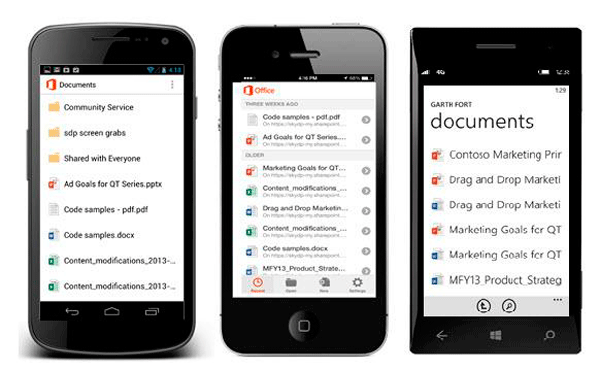Is OneDrive for Business the SharePoint alternative?
OneDrive for Business is Microsoft’s file sync, share and collaboration service. It used to be part of Office 365, but that has now changed.
Microsoft announced that OneDrive for Business will become available as a standalone subscription service on March 3. This is good news for those who want the simplicity of Dropbox, but the security and control of Office 365.
While some might see this as competition for the usual suspects in the file sharing space — Dropbox, Box, Google Drive — I think it’s a possible alternative to another, namely, SharePoint.

Along with the announcement of the standalone version, Microsoft also talked about some new and upcoming features of the file sharing service, including:
- New controls available for the most common functions directly above the Personal documents folder.
- A Site folders view that shows you the contents of Document Libraries for the Sites you are following.
- Improved search and the ability to share directly from search results.
- Easier access to OneDrive through a familiar URL structure: https://<tenant>.onedrive.com.
These are all great new features, but what’s coming is even more enticing: advanced auditing and reporting features, encryption at rest, data loss prevention (DLP), extensibility improvements and more.
The move to make OneDrive a standalone service is very smart. We’ve seen more movement in the file sharing space in the last year or more than we’ve seen with other technologies. It’s simple — people (consumer and business) are looking for ways to share and collaborate easily. The cloud allows them to do that. And services like Dropbox, Box, Google Drive and OneDrive are all going to be competing for mindshare.
But it’s not just these file sharing competitors that will have to take on OneDrive. SharePoint is going to take a big hit too. We think for many, OneDrive is the SharePoint alternative many organizations have dreamed of.
Let’s look at three ways OneDrive takes on SharePoint:
OneDrive has a very simple interface (one that has been simplified further with recent updates). So it’s easy to upload your files and share them. You can also sync to all your devices, desktop, tablet, smartphone, giving you direct access to your content when you are online or offline. You even have mobile apps for iOS, Android, Windows 8 and Windows RT.
OneDrive even has this cool feature that allows you to grab a file from your PC even if you haven’t uploaded it to OneDrive. You have to turn that feature on, but it’s pretty nice to have.
SharePoint’s interface is OK, but it’s the subject of much debate. It’s not very intuitive to use and requires a fair amount of planning and organizing to get it set up in a way that’s easy for people to understand.
Getting access to SharePoint on mobile devices has been spotty at best. Access via mobile (tablet or smartphone) has improved a lot with SharePoint 2013, but for those on SharePoint 2010, the story is not so good.
Collaboration is the name of the game these days and easy ways to collaborate are critical for any organization. OneDrive enables you to collaborate easily with people inside and outside your organization. OneDrive supports collaboration through Office Online or Office client applications, and supports asynchronous editing. In addition, OneDrive has automatic version control, so you can be sure everyone is always working with the most recent version of a document.
When you are in the same organization, collaboration with SharePoint is easy. But if you want to collaborate with people outside your organization, then you have to do some administration work. So it’s not as easy as clicking a share button.
A point to note here is that with SharePoint 2013, you are using OneDrive for collaboration in most cases anyway. So if all you are doing is using SharePoint to store your documents, then why wouldn’t you just use OneDrive?
OneDrive for Business supports a number of industry standards such as ISO 27001, EU Model clauses, HIPAA BAA and FISMA. You can also generate audit reports, adjust controls for external sharing, offline synchronization and access control.
You also get support for these industry standards with SharePoint 2013 on premises. So the question is, would you pay to license, install and implement SharePoint when you can get most, if not all of your security requirements met with OneDrive for Business? I’d like to see the business case for that decision.
The best thing about OneDrive is the upgrade path is straightforward. You start with OneDrive to get all your file sharing and collaboration capabilities. When you are ready for email and more advanced productivity capabilities, you can connect into Office 365 and you’re off running.
The move from SharePoint on premises to Office 365 can be done, but it’s not simple or straightforward and requires much planning. OneDrive and Office 365 are both cloud services and OneDrive’s user interface and experience is designed from Office 365, so it’s much easier to make the shift.
In the end, as I always say, what tool you use depends greatly on what your needs are. OneDrive for Business, Office 365, SharePoint 2013 — all have many of the same features, but each one offers progressively more capabilities than the other.
What do you think? Is OneDrive for Business an alternative for SharePoint on premises?
Steve Pogrebivsky is co-founder and CEO of MetaVis Technologies
